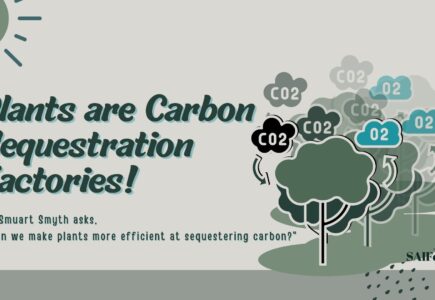The vital human-plant relationship
Humans and plants have a beneficial relationship, we breathe out carbon which through photosynthesis, plants use for growth and in this process they emit oxygen. In the photosynthesis process, carbon is converted into oxygen, a cycle which has occurred since the dawn of terrestrial life and is an essential component of life on our planet. In essence, plants are biological factories that convert carbon to oxygen and in the process of doing so, keep humanity fed. It is also an essential process for plant life. Plants take in water, light, and carbon dioxide, to produce energy to sustain themselves, with oxygen being a beneficial result of this process for us humans.
In thinking about plants as factories, a better understanding of how a plant could be more efficient when it comes to taking in carbon dioxide and producing oxygen represents an important area for innovation. Plant chlorophyll which is located in the leaves requires sunlight to be able to absorb the energy from light waves and undertake photosynthesis. If a plant is in the shade, it may have a reduced rate of photosynthesis, depending on which of the three forms of photosynthesis it uses, and whether it absorbs blue or red light waves. However, a plant in the shade does not necessarily photosynthesize less, it all depends on several factors like the light it absorbs, the structure of the leaves, moisture conditions, and whether it is a shade-tolerant plant. While this is more detail than we need for this blog, just know that not all forms of photosynthesis are equal.
This leads us to ask if we know plants need to photosynthesize to live, if they photosynthesize less, does that mean they grow less or have lower yields? If this is true, is the opposite true also? We know that there are plants that can successfully grow in the shade, so could a plant be created that have higher rates of photosynthesis to improve growth and yield?
Effects of increased plant photosynthesis
The short answer is yes! Increasing the ability of a plant to photosynthesize increases yield (growth). This has already been proven in soybean research conducted in the USA, where soybeans were bioengineered (through genetic modification), to have higher rates of photosynthesis. These varieties had higher plant biomass, ranging from 14-21% higher. The average yield increase for the soybean varieties that were tested was 25% higher, with the greatest yield increase being 33%. The results of De Souza et. al. research are available here.
Impacts on food security and beyond
The discoveries from this innovative research could have far-reaching impacts. The application of similar technology to other food crops beyond soybeans could increase yields of all the commonly consumed crops, fruits and vegetables. An increased yield could also mean that the GM varieties may result in greater amounts of carbon sequestered. Of course, this needs further investigation and will depend on the crop type, but it could have environmental benefits.
If this technology was bred into staple crop varieties of food insecure countries, the higher yields could have significant beneficial impacts on the United Nations Sustainable Development Goals of reducing poverty (#1), ending hunger (#2) and ensuring human health (#3). Reducing food insecurity in a substantial way is going to result from innovation. Ending conflict and other distribution problems will have marginal improvements, the solution lies in innovation.
What to Consider
It’s not as simple as increasing our crops’ rate of photosynthesis and we will have all these great benefits. Of course, that is the goal, but having worked in this area of research for decades, I am not naïve about the reality of science, policy, or consumer acceptance. It’s important to recognize that increasing a plant’s ability to photosynthesize and potentially increase yields will impact its environment. Increased photosynthesis will also require increased water intake and soil nutrients. This will have some impact on ecosystems, such as water, soil, and soil microbes and organisms. Further research will need to be done to better understand these relationships.
Depending on what the research findings are, the crop type, and the nation, these crops could be a few years, to a few decades away. Consumer acceptance will play a role in the success of this technology’s development and adoption. If this is something you think is of value to our lives and environment, let your politicians know. We can easily see these GM technologies being transferred to ornamental crops, which might have a higher consumer acceptance, as they are planted in our yards and are not in our food systems. If a person could plant a rose bush or tulip bulb that would sequester more carbon, would consumers view this technology more favourably? Or if your tomato or cucumber plants could sequester more carbon and have higher yields, would this alter their perspectives on biotechnology in food? If so, just don’t put it in zucchini, we never need more zucchini!



Most plants respond to increased levels of CO2.There is a large data base available on line. Greenhouse growers add carbon dioxide to an ambient of 1,200 ppm. All other nutrients must be provided to support the anticipated yield.
Thanks, Dennis for the comment. If this is an avenue of research we see make it to the market, there will be a large component spent on ensuring that there is a balance of nutrients provided. It’s a chemical reaction, you can’t just keep increasing one input and expect to get an equal output. We discussed when editing this post also the ecological impacts, if more CO2 is converted into yields, along with other nutrients, there will be an impact on the ecosystem. Unfortunately, this becomes to large of a discussion for one post, as it could be a positive impact or a mixed bag.